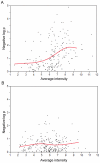A novel molecular signature identified by systems genetics approach predicts prognosis in oral squamous cell carcinoma
- PMID: 21853135
- PMCID: PMC3154947
- DOI: 10.1371/journal.pone.0023452
A novel molecular signature identified by systems genetics approach predicts prognosis in oral squamous cell carcinoma
Abstract
Molecular methods for predicting prognosis in patients with oral cavity squamous cell carcinoma (OSCC) are urgently needed, considering its high recurrence rate and tendency for metastasis. The present study investigated the genetic basis of variations in gene expression associated with poor prognosis in OSCC using Affymetrix SNP 6.0 and Affymetrix GeneChip Human Gene 1.0 ST arrays. We identified recurrent DNA amplifications scattered from 8q22.2 to 8q24.3 in 112 OSCC specimens. These amplicons demonstrated significant associations with increased incidence of extracapsular spread, development of second primary malignancies, and poor survival. Fluorescence in situ hybridization, in a validation panel consisting of 295 cases, confirmed these associations. Assessment of the effects of copy number variations (CNVs) on genome-wide variations in gene expression identified a total of 85 CNV-associated transcripts enriched in the MYC-centered regulatory network. Twenty-four transcripts associated with increased risk of second primary malignancies, tumor relapse, and poor survival. Besides MYC itself, a novel dysregulated MYC module plays a key role in OSCC carcinogenesis. This study identified a candidate molecular signature associated with poor prognosis in OSCC patients, which may ultimately facilitate patient-tailored selection of therapeutic strategies.
Conflict of interest statement
Figures




Similar articles
-
Somatic copy number alterations detected by ultra-deep targeted sequencing predict prognosis in oral cavity squamous cell carcinoma.Oncotarget. 2015 Aug 14;6(23):19891-906. doi: 10.18632/oncotarget.4336. Oncotarget. 2015. PMID: 26087196 Free PMC article.
-
Identification of AUNIP as a candidate diagnostic and prognostic biomarker for oral squamous cell carcinoma.EBioMedicine. 2019 Sep;47:44-57. doi: 10.1016/j.ebiom.2019.08.013. Epub 2019 Aug 10. EBioMedicine. 2019. PMID: 31409573 Free PMC article.
-
An Ultra-Deep Targeted Sequencing Gene Panel Improves the Prognostic Stratification of Patients With Advanced Oral Cavity Squamous Cell Carcinoma.Medicine (Baltimore). 2016 Feb;95(8):e2751. doi: 10.1097/MD.0000000000002751. Medicine (Baltimore). 2016. PMID: 26937903 Free PMC article.
-
What real influence does the proto-oncogene c-myc have in OSCC behavior?Oral Oncol. 2011 Aug;47(8):688-92. doi: 10.1016/j.oraloncology.2011.05.016. Epub 2011 Jun 25. Oral Oncol. 2011. PMID: 21708481 Review.
-
Systems genetics analysis of oral squamous cell carcinoma susceptibility using the mouse model: current position and new perspective.Mamm Genome. 2021 Oct;32(5):323-331. doi: 10.1007/s00335-021-09885-1. Epub 2021 Jun 21. Mamm Genome. 2021. PMID: 34155540 Review.
Cited by
-
Gα₁₂ drives invasion of oral squamous cell carcinoma through up-regulation of proinflammatory cytokines.PLoS One. 2013 Jun 7;8(6):e66133. doi: 10.1371/journal.pone.0066133. Print 2013. PLoS One. 2013. PMID: 23762476 Free PMC article.
-
Therapeutic Targeting of BRD4 in Head Neck Squamous Cell Carcinoma.Theranostics. 2019 Feb 28;9(6):1777-1793. doi: 10.7150/thno.31581. eCollection 2019. Theranostics. 2019. PMID: 31037138 Free PMC article.
-
High RAB25 expression is associated with good clinical outcome in patients with locally advanced head and neck squamous cell carcinoma.Cancer Med. 2013 Dec;2(6):950-63. doi: 10.1002/cam4.153. Epub 2013 Oct 31. Cancer Med. 2013. PMID: 24403269 Free PMC article.
-
Role of β-catenin in cisplatin resistance, relapse and prognosis of head and neck squamous cell carcinoma.Cell Oncol (Dordr). 2018 Apr;41(2):185-200. doi: 10.1007/s13402-017-0365-1. Epub 2017 Dec 14. Cell Oncol (Dordr). 2018. PMID: 29243047
-
Immune infiltration at the primary tumor is associated with clinical outcome of patients with extranodal extension of lymph node metastasis in oral cancer.Oral Oncol. 2024 Jun;153:106729. doi: 10.1016/j.oraloncology.2024.106729. Epub 2024 Apr 24. Oral Oncol. 2024. PMID: 38663156 Free PMC article.
References
-
- Cancela Mde C, Ramadas K, Fayette JM, Thomas G, Muwonge R, et al. Alcohol intake and oral cavity cancer risk among men in a prospective study in Kerala, India. Community Dent Oral Epidemiol. 2009;37:342–349. - PubMed
-
- Liao CT, Wang HM, Chang JT, Ng SH, Hsueh C, et al. Analysis of risk factors for distant metastases in squamous cell carcinoma of the oral cavity. Cancer. 2007;110:1501–1508. - PubMed
-
- Liao CT, Huang SF, Chen IH, Chang JT, Wang HM, et al. Risk stratification of patients with oral cavity squamous cell carcinoma and contralateral neck recurrence following radical surgery. Ann Surg Oncol. 2009;16:159–170. - PubMed
-
- Yen TC, Liao CT. Statistical Issues Involved in “Risk Stratification of Patients with Oral Cavity Squamous Cell Carcinoma and Contralateral Neck Recurrence Following Radical Surgery”. Ann Surg Oncol 2010 - PubMed
-
- Liao CT, Chang JT, Wang HM, Ng SH, Hsueh C, et al. Analysis of risk factors of predictive local tumor control in oral cavity cancer. Ann Surg Oncol. 2008;15:915–922. - PubMed
Publication types
MeSH terms
Substances
LinkOut - more resources
Full Text Sources
Other Literature Sources
Medical
Molecular Biology Databases

